Planning a big website change? You’re going to need an ambitious SEO migration strategy to match. Moving to a new domain or redesigning your site is exciting, a fresh start, pastures new for your business. But it is very risky for your prized SEO. A careless migration can tank your hard-earned search rankings and organic traffic, and leave your team scrambling for emergency fixes.
Fortunately, better outcomes are possible and we are going to help you achieve them. You can make the move without losing any traffic at all, and by putting your website and brand on sound SEO footing for years to come.
In this SEO migration guide, you’ll learn:
- What SEO migration is (and why it’s important)
- What elements of SEO you need to carry over during migration
- A step-by-step checklist to plan and execute a successful migration
- Common mistakes that cause traffic drops and how to avoid them
Let’s get started.
- What is SEO Migration?
- The Risks of a Poorly Planned SEO Migration
- The Long-Term SEO Benefits of Doing it Right
- Types of Website Migrations
- Website Migration Checklist: Essential SEO Best Practices
- SEO Migration Tips When Redesigning a Website
- WordPress SEO Migration: Best Practices for Seamless Transition
- SEO Migration for Custom CMS Platforms
- Ecommerce Platform Migration SEO
- Enterprise SEO Site Migration
- Essential Tools and Software to Support Your SEO Migration
- Post-Migration Monitoring: What Metrics to Track and When
- Common SEO Migration Mistakes
- Final Thoughts: Setting your site up for SEO success
What is SEO Migration?
SEO migration is the process of moving a website (or parts of it) to a new domain or platform while keeping its current search engine visibility and rankings intact. Most website migrations target improved performance or user experience. This might require changing domains, switching hosting providers, moving to a new CMS, or completely overhauling the site’s design.
As you’d expect with such a big change, there’s lots to get sorted. You’ll need a dash of technical wizardry to set up 301 redirects and shift data migration, and a whole heap of strategic planning for tasks like mapping old URLs to new URLs and matching your new site structure with existing target keywords and user content.
The key to all of this is ‘preservation’. You want to at least maintain your current SEO performance, the status quo, so users can still find your content through organic search results. You basically want Google to know that you’re moving, but nothing has really changed — you’re still trustworthy with great copy and blogs that people want to read.
A few things you’ll want to preserve or update when you make the move include:
- Traffic
- Rankings
- Backlinks
- Domain authority
- Indexed pages
- A robust sitemap structure and internal link architecture
- Structured data and schema markup
As you can see, there are quite a few technical ‘under the hood’ elements that are at risk. If you can get it wrong, things can quickly go awry for your SEO campaigns.
The Risks of a Poorly Planned SEO Migration
There’s no way of sugarcoating the disastrous effects of a poorly planned SEO migration. If you don’t get everything in place and do things properly, it can effectively torpedo your search rankings and traffic in an instant. All the work you’ve put into building your domain authority and getting your pages to the top of Google results can be undone overnight.
Here are a few things that will give your SEO experts sleepless nights:
- Lost search rankings for your most important pages
- Big drops in organic traffic
- Broken links and crawl errors that make your site almost unusable
- Duplicate content issues that are difficult to rectify
- Slow site speeds and poor technical performance
- Negative user experiences that hurt your brand image
If you’ve experienced a loss of traffic after one of Google’s core algorithm updates, you’ll know how even a temporary dip in SEO visibility can affect your business. Fewer clicks and fewer visitors mean less revenue.
A badly executed site migration is a whole different ballgame. So many things can go wrong that it can take weeks or even months to repair the damage. And then you will have to slowly, with all your might, climb back up the hill to retrieve your rankings and visibility.
That’s why you need an SEO migration plan. Preparation is everything.
The Long-Term SEO Benefits of Doing it Right
Doing it right the first time will save you the stress and headaches of retroactively trying to salvage a poor migration and lay the groundwork for multiple long-term benefits. While SEO is never a ‘set and forget’ process, a well-executed migration can lead to:
- Improved site architecture that’s easier for visitors to traverse
- Consolidated and cleaned-up URL structures
- Fresh on-page content that better targets your audience
- More efficient crawlability and indexing
- Maintained or improved search engine rankings with valuable links and domain authority preserved when the site is reindexed
- Lower ongoing SEO maintenance costs compared to other marketing channels
- Less reliance on paid advertising with organic SEO delivering steady steams of traffic
There are risks involved. But if you put an SEO migration plan in place, it’s an opportunity to improve or enhance pretty much every facet of your website. You can tighten up its structure, fix lingering SEO problems, improve load speed and usability, and start again with renewed visibility.
It’s a launchpad for you to fulfill your potential and get the traffic and rankings your business deserves.
Types of Website Migrations
There are different types of website migrations. It’s not always a case of simply moving from one domain to another. Understanding the migration you need to undertake, how complex it is, and the risks involved will help you to plan accordingly.
Here are the most common website migration types.
- Domain change - Moving from oldsite.com to newsite.com.
- Replatforming - Moving a site to a new content management system. For example, you might want to switch from WordPress to Webflow to improve performance or security.
- Site redesign - Redesigning an entire site or just a few pages with a focus on updating on-page elements such as content and layout.
- New site structure - Overhauling a site by recategorizing sections and updating URLs.
- Website consolidation - Combining multiple websites into one.
- HTTP to HTTPS migration - Moving to a more secure HTTPS protocol.
- Site location change - Moving from one top-level domain to another like site.co.uk to site.com
Website Migration Checklist: Essential SEO Best Practices
When making major technical or structural changes to your site, you must be diligent and follow a structured process from A to B. Take your time, do things slowly, step by step, before, during, and after the migration. Having a checklist of best practices to run through helps to navigate the minefield of website migration without losing precious organic traffic.
The following best practices cover pretty much everything you need to do, from initial planning to monitoring everything after the switch.
Conduct a Full Site Audit
Start by taking a snapshot of your website’s SEO with a full-site audit. This is essentially a health check to see what’s working and needs improvement. More importantly, it will serve as a sort of migration baseline — a reference point for when you make the move.
A full site audit is quite exhaustive. You can use tools like Screaming Frog and SEMrush to get pages upon pages of data and metrics about your site. An audit should include:
- Current keyword rankings (and which pages they map to)
- Top-performing pages by traffic, conversions etc.
- Internal link structure
- Backlink profile, including any broken links
- Page speed and Core Web Vitals metrics
- Mobile-friendliness and responsive design checks
- Indexing status and crawl errors
- Metadata review of things like titles and header tags
- Exports of your sitemaps and robot.txt files
- Security protocols like HTTPS status and SSL certificates
There’s quite a bit to get through here. You will need technical experts to make sense of the full report. But this is your benchmark, what you want to build from.
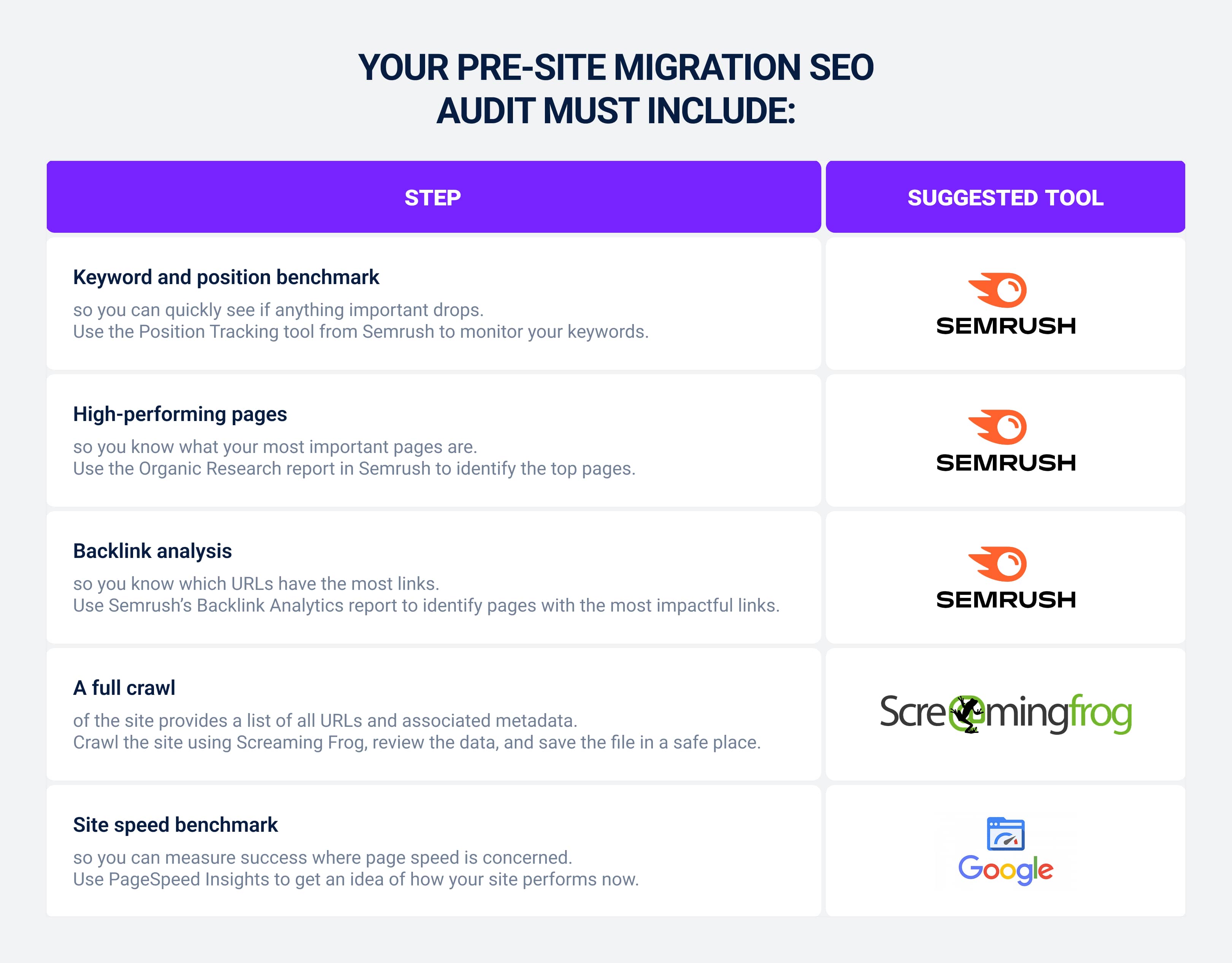
Backup Your Website
If everything fails, you need a safety net to fall back on. Create a full backup of your existing site before you even make one small change. It will give you peace of mind that you can restore things back to normal if something goes wrong.
Using WordPress? There are multiple plugins you can use to create a full back up of your site, including files and the database. Just remember to test these backups before you start the migration. You need to know that they’re complete and functional if the worst happens.
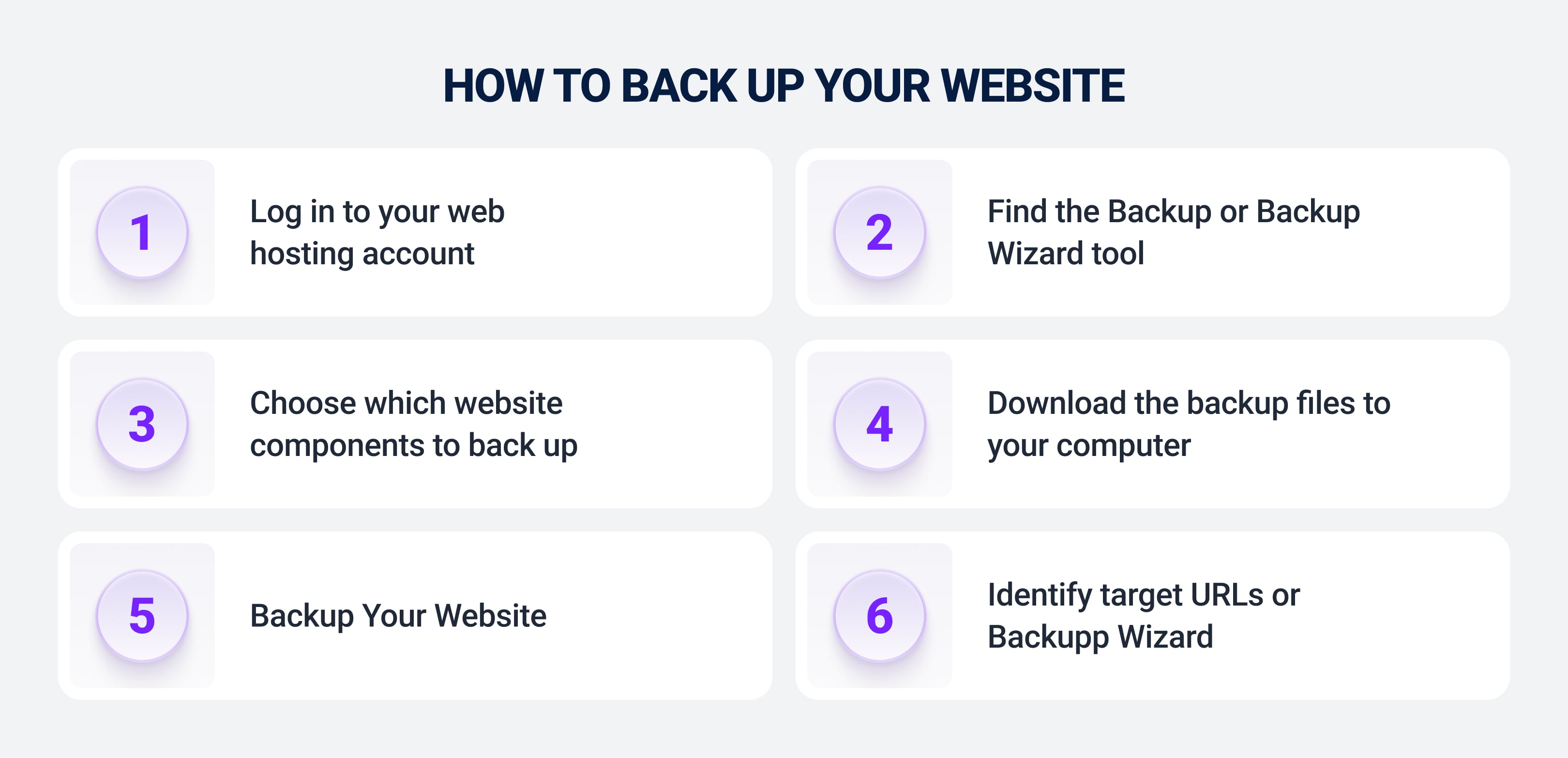
Identify Target URLs for Migration
Next, you need to start building a list of target URLs for migration.
Start with the ones that have the most SEO value. These are your ‘top’ pages. They might be transactional pages that drive conversions, or though-leadership content that ranks well. You want to hold tight on to the equity of these pages so they are preserved, in all their glory, after the migration.
You can use Google Search Console for this. Here, you can filter the performance of pages based on ‘clicks’ or ‘average engagement time’ and then export the data to a Google Sheet.
It’s not that other pages don’t matter — you’ll need to create an inventory of all the URLs need for migrations. But start with the most valuable and work down.
Map Old URLs to New URLs
Now for the big part. Connecting the dots between your old URLs and new URLs. You want everything redirected to your new home, one to one, so there aren’t any broken links. Every old URL needs a new destination, even if it’s just a redirect to a relevant page. Do it correctly and it will be a breeze for search engines to navigate and index your new site next time round.
- Build a big URL mapping spreadsheet that maps every old URL to a new destination
- Include all the essential metadata
- Note down the traffic data to prioritize your high value pages
- Get multiple stakeholders and team members to review the map
Set Up 301 Redirects
301 redirects are used to tell Google (and visitors) where your content has moved to. These will point everyone in the right direction to the correct page, even if they input your old URL into the address bar. And it will transfer all that vital SEO equity so it doesn’t get lost in transit.
This is a technical task that must be implemented at the server level by modifying configuration files, so defer to the experts!
Again, try not to rush. Larger sites are likely to benefit from doing redirects in batches and monitoring how things go to flag issues and prevent server overloads.
Test Redirects Before Migration
Never greenlight redirects on a live site without testing. You can set up a staging environment that mirrors your production setup exactly to try everything out before doing it for real. Monitor these every few days to make sure they function correctly. It’s always easier to fix things in staging, too, rather than troubleshooting them afterwards.
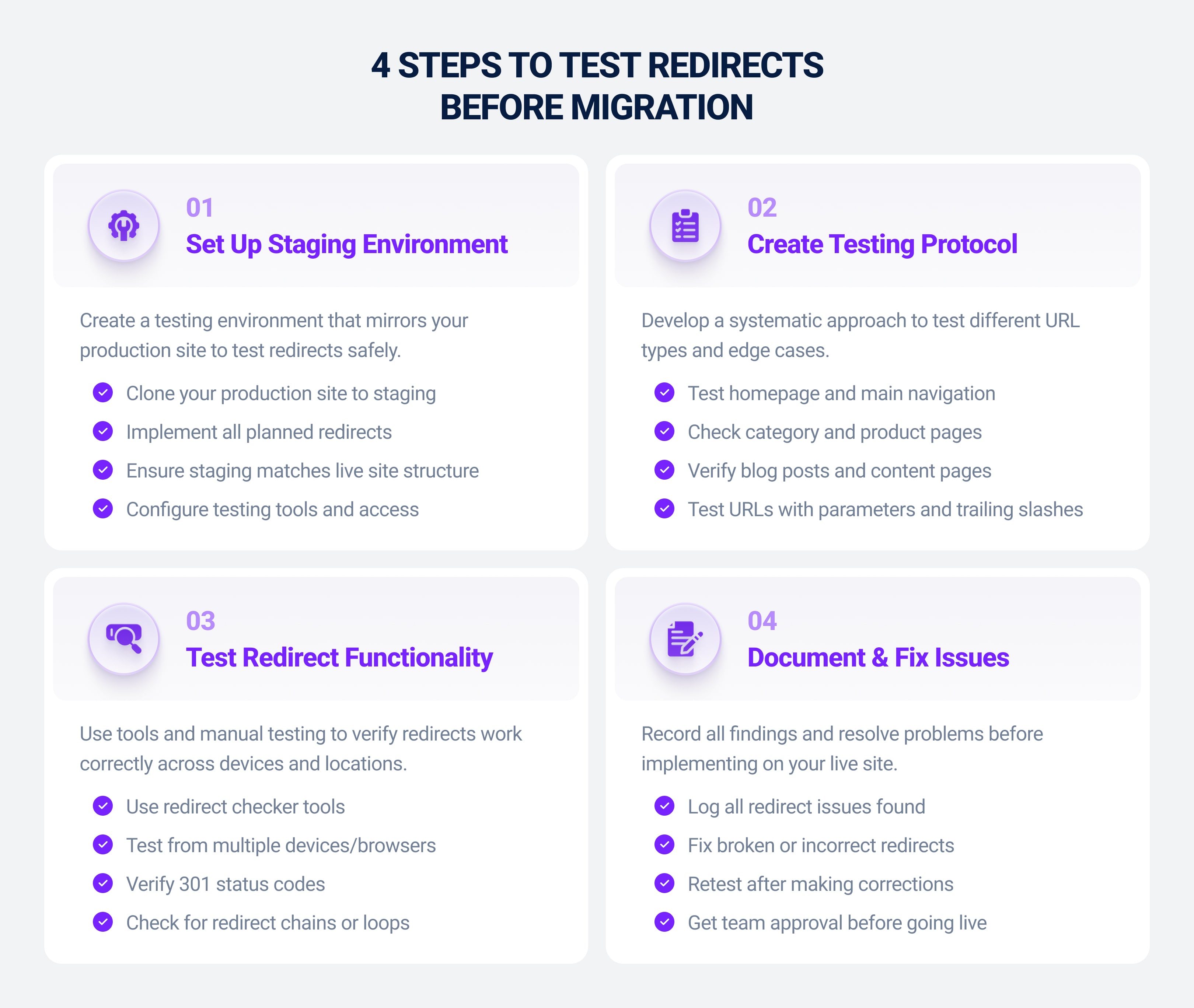
Update Internal Links
You’ll likely have built up a lot of internal links between pages for SEO on your current site. Unfortunately, you can’t rely on redirects to do the heavy lifting here. Go through each of your pages manually and update all the internal links so they point to the new URLs. You can use find-and-replace tools to make it less arduous.
Start with most important ones: navigation menus, contextual links in your high-ranking blogs, footer links etc. Then move onto the rest. And don’t forget links in widgets or sidebars, as these often make up a big portion of your internal link structure.
Verify Correct Canonical Tags
Canonical tags are HTML elements that prevent duplicate content from causing big problems with your site migration. They tell search engines that a particular page is a master ‘copy’ — the authoritative source. When migrating, you want your canonical tags to point to the new URLs.
- Extract the canonical tags from your website audit
- Make sure each tags points to the new URL
- Fix issues with missing canonicals or those pointing to redirected URLs
- Verify canonicals using Google Search Console’s URL Inspection Too
Update XML Sitemap
The XML sitemap tells Google exactly where everything is so it can crawl and index the pages on your site. You’ll need a new one after migrating, prepared in advance and ready to be submitted on the day your site goes live. This will help search engines to get up to speed with your new structure more quickly, and smooth the path to preserved rankings.
The sitemap should include all your new URLs and have no trail or references to any of your old ones.
Update Robots.txt
Robots.txt files are like digital gatekeepers. You can use them to prevent crawlers from accessing certain directories or files. Obviously, you want all your important pages to be indexed after migrating. The onus here is on making sure key areas of your site are not accidentally blocked.
A quick few steps to run through here:
- Remove old URLs from your robots.txt
- Add your new sitemap to the robots.txt file
- Test your robots.txt file using Google Search Console to double-check everything is working correctly
Inform Google Search Console of Changes
You can use the Change of Address tool in Google Search Console to formally disclose your migration from one domain to another. This helps Google understand what’s happening so it can update its index accordingly. You’ll need to set up a new ‘property’ in Google Search Console as well.
Here’s how it works:
- Set up your new domain as a new property in GSC
- Implement your 301 redirects
- Use the Change of Address tool to update the old domain in GSC
- Monitor both properties, old and new, during the transition period
GROW YOUR INSTAGRAM FOLLOWING VIA OUR CELEBRITY CAMPAIGNS
Leverage the power of the worlds A-list celebrities to grow your Instagram every month
VIEW CAMPAIGNSMonitor Traffic Pre- And Post-Migration
Major dips in traffic are a telltale sign of bigger problems. You want to keep a close eye on this metric, during each stage of the migration, to make sure it holds up.
Circe back to your initial benchmarks. You can use these to keep tabs on any fluctuations after completing the migration.
To monitor traffic from start to finish, you can:
- Set up automated alerts in Google Analytics and Search Console so your team get instant notifications when traffic drops or increases.
- Create custom dashboards to get quick overviews of all key SEO metrics and send reports to stakeholders.
- Dig down and filter data in GSC by country, query, and per page to spot trends rather than relying on broader, sitewide metrics.
Test Site Speed After Migration
Nothing will turn away visitors faster than slow load times. It even affects conversions — a HubSpot study found sites that load in 1 second have conversion rates of 40% compared to 34% for 2 seconds. The average website load time is around 2.5 seconds. But faster is always better. Page speed is a ranking factor too.
You can test site speed after you’ve migrated using several tools, including:
- Google PageSpeed Insights
- Pingdom
- WebPageTex
- GTmetrix
Do it for both desktop and mobile performance. Then compare the results with the old site and use the benchmarks to optimize load times. Pay close attention to the Core Web Vitals, as these are used by Google to evaluate a page’s experience.
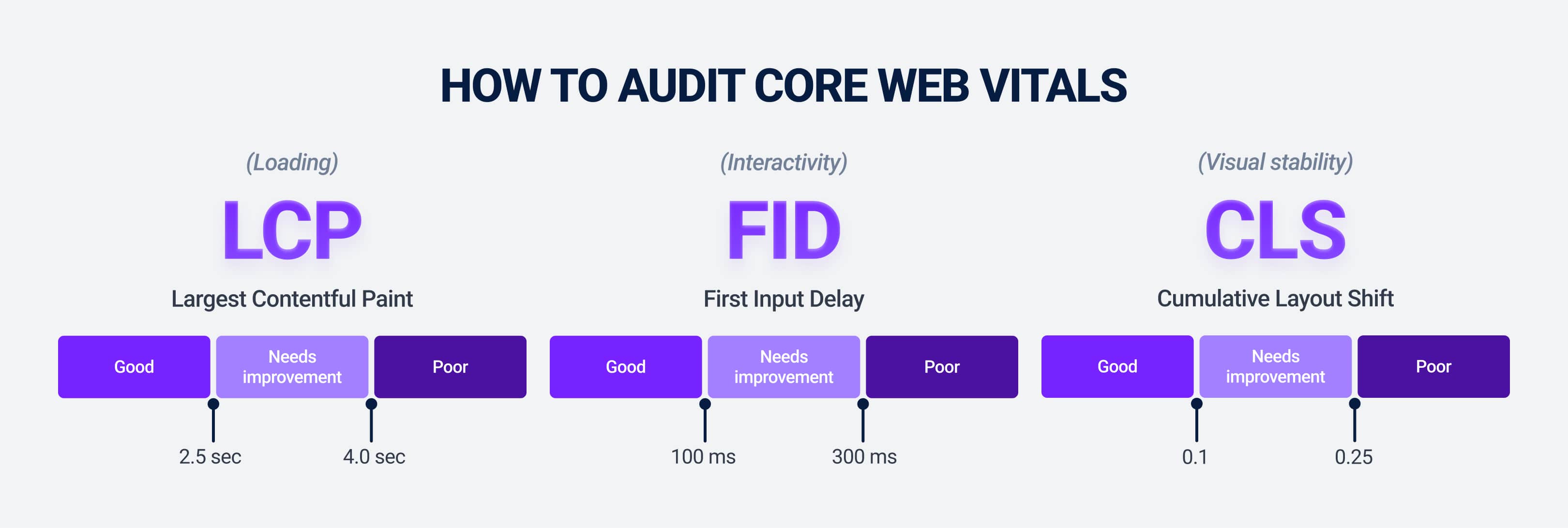
Check for Crawl Errors
Crawl errors can derail a site migration. They prevent search engines from finding and accessing your new pages. During the process, regularly identify and fix these errors, plus soft 404s and server issues, using Google Search Console and tools like Ahrefs Site Audit.
When the migration is done, run the rule over these stats daily to make sure the new site is being crawled. Any big drops in the crawl rate are a sign of technical issues that must be addressed.
Ensure Mobile Optimization
Two-thirds of website traffic now comes from smartphones and tablets. Google also uses the mobile version of your site for ranking and indexing. To get your site up to the standard everyone expects for mobile devices, you can:
- Test it across multiple devices and screen sizes. Pay close attention to loading speeds and how easy it is to navigate menus.
- Verify that all your important content and features work just as well on mobile as they do on desktop.
- Use Google’s Mobile-Friendly Test too to flag any issues.
- Monitor Core Web Vitals and other metrics on mobile.
Monitor Organic Rankings
Organic rankings are the end game for SEO. This is where all your efforts bear fruit — if things go well, and where you’ll really feel the negative effects if a migration doesn’t go to plan. Keep an eye on keyword rankings after moving from staging to a live environment. Use any dips or recoveries to inform your next steps.
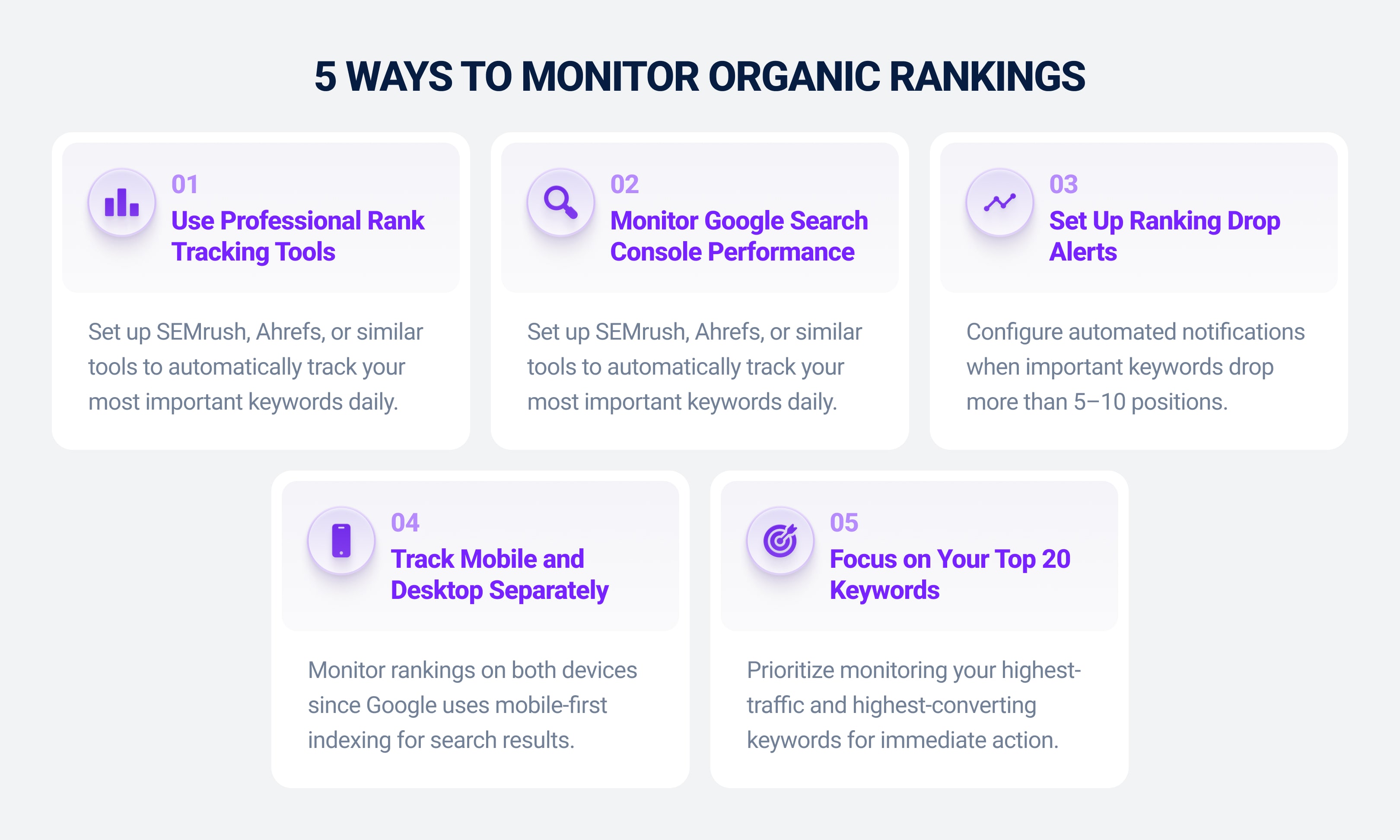
Track Performance Using Analytics
You can spin out your traffic tracking to other stats to monitor user behavior and engagement metrics on your new site. Use Google Search Console and Google Analytics to keep tabs on:
- Bounce rate
- Click-through rate (CTR)
- Pages per session
- Average session duration
- New vs returning users
- Conversion rate
- Impressions
- Indexed pages
Test Broken Links
Broken or “dead links” are going to really frustrate users while obliterating your engagement metrics. This only leads to one outcome: much lower search engine rankings. Again, tools like Screaming Frog are great for testing your links to pinpoint 404 errors. And continue to do it for a while after the migration. New broken links can pop up over time as external sites change or remove content you’ve linked to.
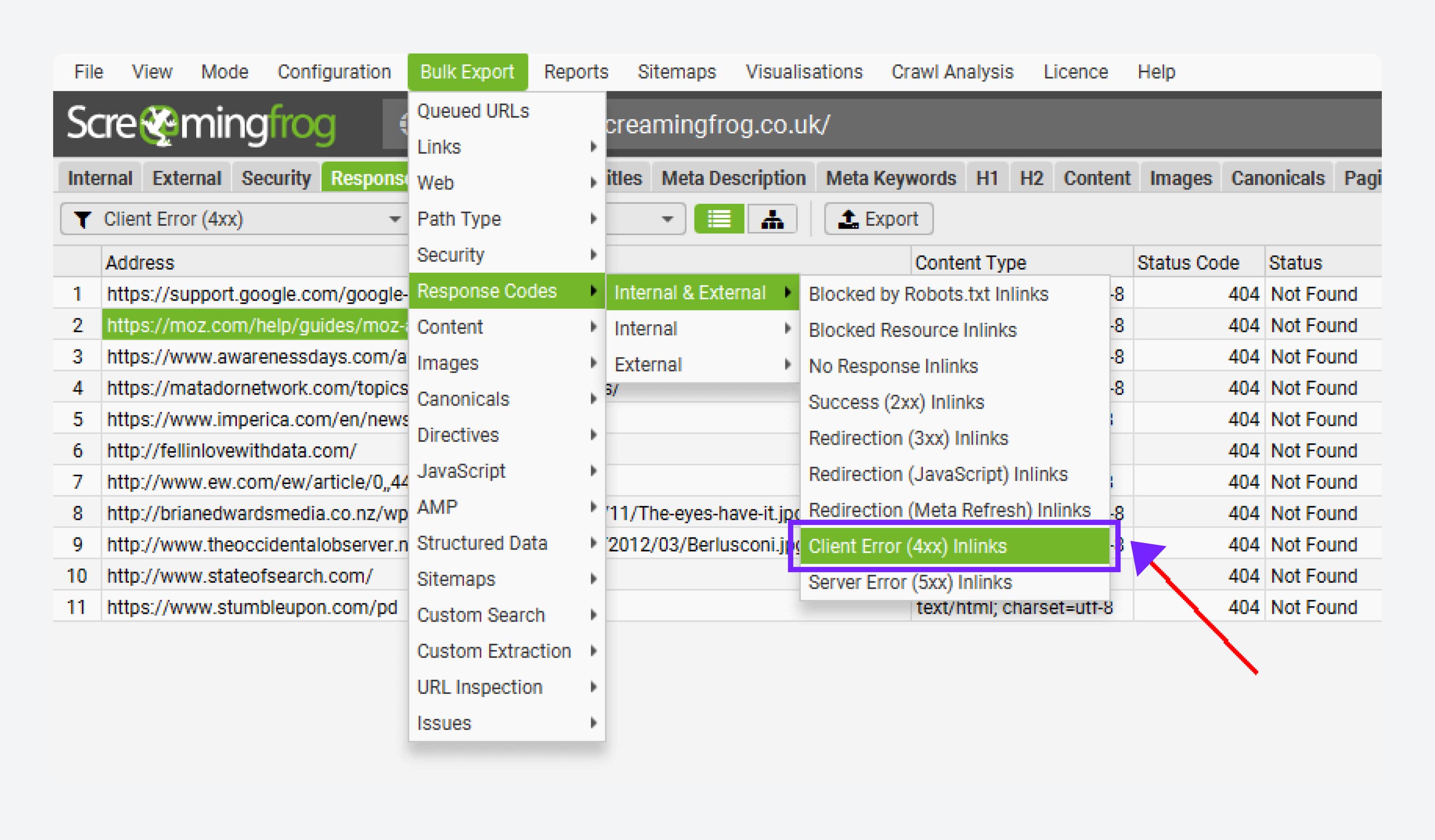
Review Content and Metadata
It’s time for another baseline check. All content should be the same (or improved). To review your content, you can:
- Check for any truncated or reformatted content in tables or embedded media.
- Verify that all meta descriptions and titles are displaying correctly in search results
- Review the content hierarchy on your new site. You want your tags (H1, H2, H3) to be structured the same for search engines.
- Test your most important pages first to confirm all the metadata elements made the transition from old to new without a hitch.
Ensure No Duplicate Content
All your work on canonicals will come in handy here. This should just be a case of quickly consolidating your thin or duplicate pages. Remember that any duplicate pages can ‘dilute’ your rankings, so you want only your new URLs to be accessible. Also, double-check your redirects are working as intended.
Test for Indexing Issues
A quick way to see which pages Google is indexing is by entering ‘site:’ and then your domain name into the search box. After pressing enter, you’ll see a full list of the indexed pages. You can also check coverage reports in GSC or manually use the URL inspection tool to look at how specific pages are faring.
Keep Monitoring for Several Weeks
SEO migration is a process. While there is a lot of hard work leading up to the point of migration, you’ll still need to monitor your site’s performance for a while after, ideally for another 3 or 4 months. To keep on top of everything, create a monitoring schedule which includes:
- Daily checks for critical issues
- Weekly reviews of performance metrics
Like organic SEO, site migrations shouldn’t be rushed. It can take months for the full, positive impact of a well-executed migration to manifest.
Communicate Migration Details With Stakeholders
This can’t be stated enough: keep all your stakeholders and important team members in the loop during the whole process. Clear communication manages times and expectations. And make people fully aware of their role and what they need to do during the migration.
- Share status reports with clear metrics and visual aids that are easy to grasp
- Make sure everyone knows who to contact and what steps to take if big issues come up
- Offer training and support on any new systems and processes introduced during the migration
Ensure SSL Certificates Are Working
Google uses HTTPS as a ranking signal. If you’re moving from HTTP, make sure SSL — a digital certificate that encrypts data and verifies your website’s identity— is properly configured. This is effectively a badge of honor that users and search engines can trust your new site.
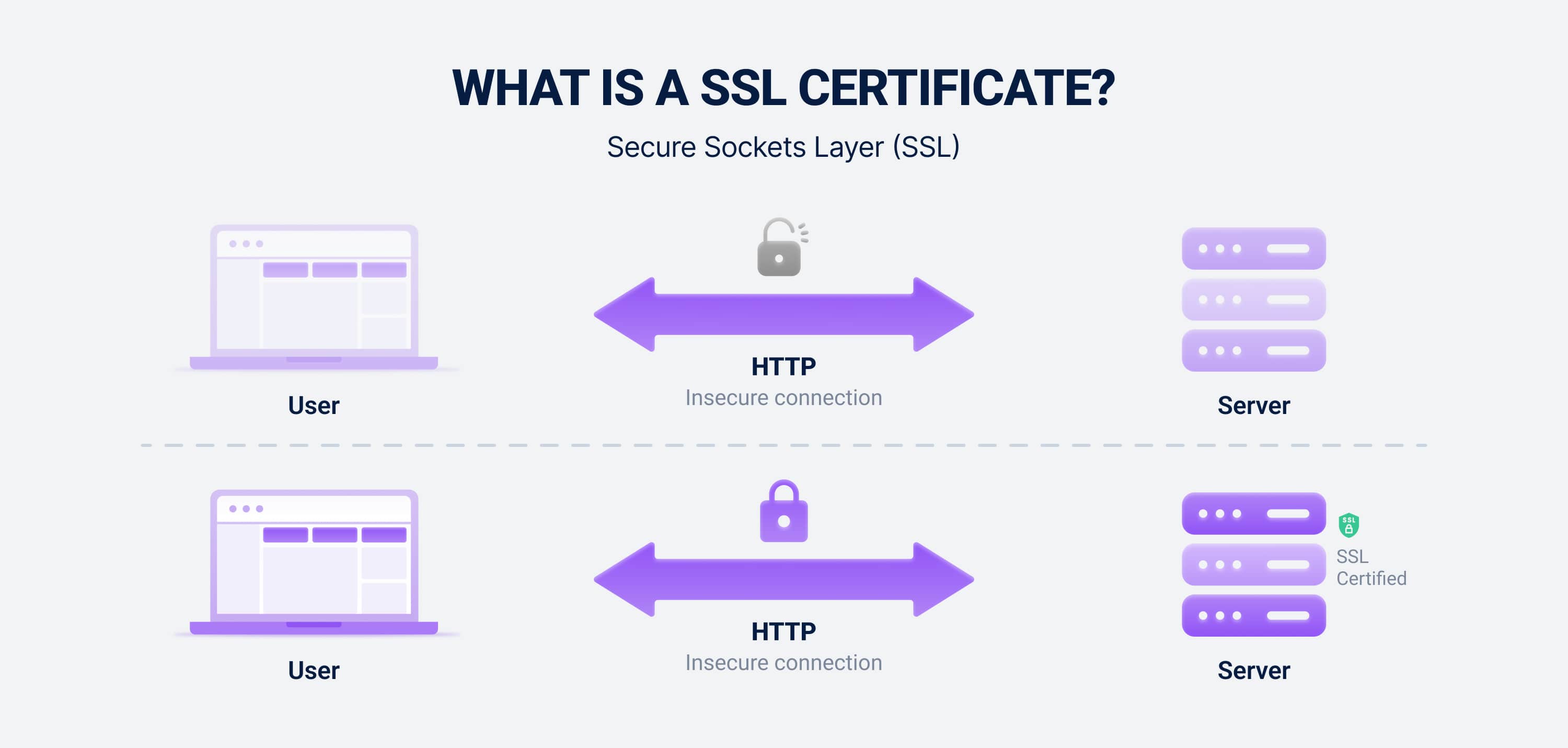
SEO Migration Tips When Redesigning a Website
Redesigning a website often involves more than just updating its appearance. It can lead to major structural changes: URL, CMS, and domain name. As well as updates to content and site hierarchy. All of these affect SEO, so they must be handled carefully.
Here are five tips for SEO migration when redesigning a website.
1. Keep URL structure (if possible)
Moving to new URLs is a painstaking process. If your existing ones are performing well and tick all the boxes for SEO best practices, it might be worth keeping them in your new design. This is one less risk to consider during the migration.
2. Plan content changes carefully
It’s common to overhaul and delete specific sections of a site during a redesign. Keep a running record of all the changes you make. And create a list of your key pages with their original word counts. That way, you can quickly spot if any crucial bits have been trimmed down or stripped of detail.
Redesigns typically involve:
- Updates - Refreshing stale copy, stats, and visuals.
- Consolidation - Combining multiple pages into stronger, ‘pillar’ pages.
- Reorganization - Changing how content is structured or grouped, like moving service pages to clearer sections.
It’s vital that your high-performing URLs continue to excel after migration.
3. Test new templates
Google will sit up and take notice when you completely revamp a top-ranking page. You’ll need to make sure your new templates have a proper heading structure with all the right SEO elements (internal linking, technical optimization, etc.) before you hit the ‘live’ button. It will make it much easier for Google to interpret your new design.
4. Consider user experience signals
Redesigns are often motivated by improving the user experience. It makes sense, then, to hone in on those all-important user metrics like bounce rate and time on site. Build with these in mind. And then keep an eye on them post-migration to gauge performance and spot issues.
5. Phase larger redesigns
The beauty of a redesign is that you don’t have to do everything at once. You can roll out changes in phases. This allows you to slowly, but surely, migrate while monitoring the impact and making adjustments.
Again, always make a backup of your existing site so you can quickly retrieve previous states if you need to later. And take screenshots of your important pages. These visual snapshots are great side-by-side references for when you design your new site.
WordPress SEO Migration: Best Practices for Seamless Transition
WordPress dominates the internet. Roughly 4 in 10 of all sites use the popular CMS. It’s user-friendly and highly customizable with a ton of themes and plugins. If you’re migrating to WordPress from another CMS, there are a few specific considerations for preserving your SEO.
1. Audit your existing content and site
Before making the jump to WordPress, map out your current site - every page, images, post, image, SEO detail. This is your virtual safety net to make sure nothing valuable slips through the cracks when you make the move.
2. Back up everything first
Don’t start migrating until you’ve made a complete backup of everything. That includes all your content, media, and databases. Having a clean back up is another safety net — a second one — so you can roll back at any time if anything breaks. The first two steps will allow you to move forward with confidence.
3. Pick tools that work together
If you aren’t going for a big redesign, find a WordPress theme that mirrors your existing look and plugins that match your current site’s functionality. It makes everything easier. Then test the whole setup. The last thing you want is a slick new design that breaks half your features.
4. Preserve SEO metadata (and set up 301s)
You want to treat your metadata with kid gloves. All the SEO titles, descriptions, and structured data should make the migration untouched. And remember to set up 301 redirects from the old URLs to the new ones so nothing messes with your rankings and traffic. WordPress plugins like All-in-One SEO and Redirection are great for both of these.
5. Test everything and clean up
When everything is live, you can run crawl tests and check for broken links. Basically, test everything like you would for a normal website migration. You can also clean up unused themes and plugins after you’ve got everything set up on WordPress. This can boost site performance.
SEO Migration for Custom CMS Platforms
If you’re migrating to or from a custom CMS platform, extra care is required for accurate and cost-effective SEO.
A custom CMS is built for a specific purpose or website. It’s not an off-the-shelf solution like WordPress. There are pros and cons to that. While a custom CMS platform is bespoke and shaped to specific workflows and integrations, it’s also less flexible with fewer templates and plugins. Basically, there’s much more manual work involved.
A few challenges include:
- Meta titles and structured data must be planned and built manually. There’s no safety net or built-in SEO features like with WordPress or Shopify.
- Harder to retrofit fixes later and add things like canonical tags or schema if they get overlooked during website development
- Redirects can’t rely on plugins. They need to be coded directly into the platform’s logic.
- Testing is even more important (and complex)
To address these unique challenges, you should:
- Get developers on board early so all SEO requirements are baked into the platform from the start
- Replicate features from the old platform. It’s important not to lose breadcrumbs, internal search optimization etc. during the transition.
- Test crawlability and indexability multiple times. It’s vital that bots can access and crawl your new site before it goes live.
Ecommerce Platform Migration SEO
Stakes are higher with ecommerce migrations. Any changes and fluctuations in traffic are very likely to directly affect sales and revenue. Larger sites face even more difficulties due to the sheer scale of product pages and complex category structures.
Category and Product URL Preservation Strategies
Product and category are usually the highest value pages for ecommerce, not blogs or articles. The fewer moving parts, the better here. You want to maintain product IDs across platforms to make it easier to map URLs. And try to keep category structures in place where possible. These are usually a goldmine for commercial keywords, so try not to mess with things too much.
Managing Structured Data and Schema Markup
Ecommerce sites rely on rich results in search engines to add visual pizzazz to listings beyond blue links. This requires careful management of structured data and schema.
- Double-check that key product details like price, availability, and reviews transfer over.
- Customer reviews are also SEO gold. Make sure both the content and the schema that powers them are carried over.
- Navigation breadcrumbs also help search engines understand your site’s structure. Verify that these work correctly on your new platform.
Updating Internal Linking and Navigation Menus
You are likely to have lucrative conversion paths on your site that you want to preserve at all costs. Many of the internal linking structures also distribute domain authority, so there’s lots to update here carefully.
- Prioritize your top-performing pages — make sure your most profitable content is a click or two away from your homepage
- Plan around how filters and sorting options create URL variations. Make sure they don’t create duplicate content issues
- Automated ‘related products’ or ‘customers also bought’ sections create valuable internal links. Double-check that these systems transfer correctly.
Enterprise SEO Site Migration
Larger, more complex websites bring their own unique challenges. There’s likely to be thousands of URLs to account for, and lots of SEO equity built up over many years. Getting all of this from A to B is complex and it will require a laser focus on collaboration and communication; and no shortage of skill from developers.
Stakeholder Alignment and Departmental Communication
From the off, it’s vital that all leaders fully understand what’s at stake and how important it is to prioritize time and resources for the migration. This then filters down across departments. Multiple teams will be involved: marketing, IT, development, and business. Everyone needs to know their exact role and responsibilities, and clear comms channels must be set up.
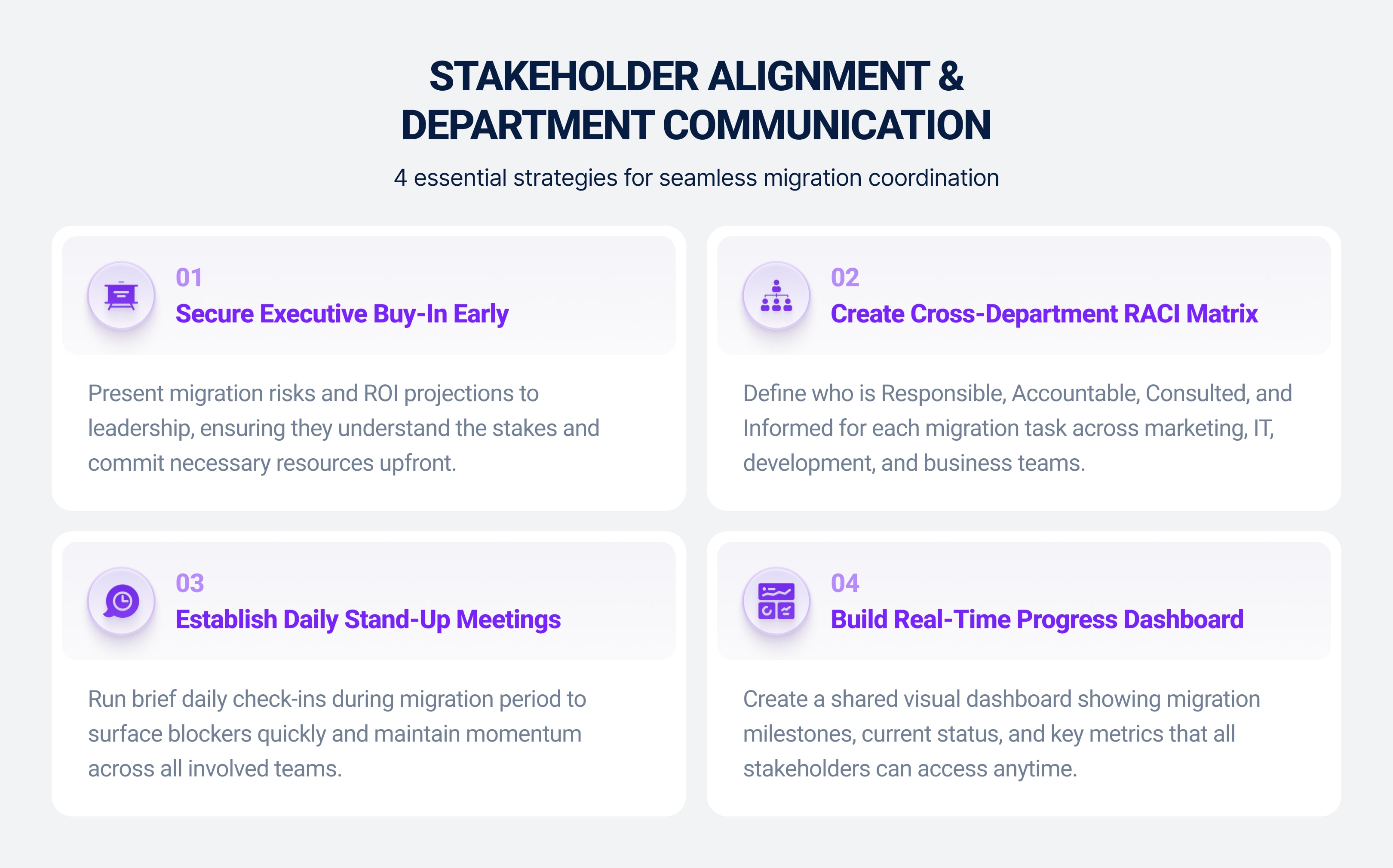
Crawl Budget Management for Large-Scale Migrations
Search engines have crawl budgets for each site. If you have 100k+ pages, that’s a lot to get through. That’s why you need to put your best pages front and center — these should be crawled and indexed first after migration.
To manage your crawl budget and support the process, you should:
- Use robots.txt and noindex tags to control crawl depth
- Prioritize important URLs in your XML sitemaps
- Use multiple sitemaps to guide search engines to your top pages
- Remove or consolidate any lower-value pages that take up crawl budget and don’t bring much to SEO
- Make sure your servers can keep up with higher crawl activity during the migration.
Handling Subdomains, Internationalization, and Complex Redirects
Enterprise SEO often involves more than one single domain. These are often very complex structures with multiple subdomains and country-specific versions. To reduce the risks involved, you can:
Consolidate subdomains where possible, moving them into subfolder structures to preserve domain authority.
Carefully plan migration for country-specific domains and localized content, making sure to handle hreflang tags and site architecture correctly.
Hire an SEO agency and work with experienced professionals to manage the entire process.
Additional tip: Large sites will benefit from using programmatic SEO to automate updates for 1K-100K+ pages.
Essential Tools and Software to Support Your SEO Migration
You’ll need a suite of different tools to get the job done. There isn’t a single piece of software that can do everything. Certain tools excel at specific tasks, though a few, like Google Search Console, will inform most of your strategy.
Here’s an overview of the tools you can use:
| Feature | Tools |
|---|---|
| Crawling and site analysis | Screaming Frog, Sitebulb, DeepCrawl |
| Redirect testing | Redirect Checker, HTTP Status. Io, Redirect Path |
| Rank Tracking | SEMrush, Ahrefs, Mioz |
| Analytics and performance | Google Analytics, Google Search Console |
| Database and content migration | All-in-One WP Migration, Migrate Guru, custom scripts |
| Sitemaps | XML-sitemaps.com |
| Project Management | Trello, Sana, Monday.com |
Post-Migration Monitoring: What Metrics to Track and When
After your new site goes live, it’s time to track metrics to measure the impact of your migration and catch any issues to act on. Setting up automated alerts for big changes will reduce the burden on your teams.
Metrics to monitor daily during the first two weeks:
- Organic traffic levels
- Critical crawl errors
- Server response times
- Core conversion metrics
Metrics to monitor weekly during the first two months:
- Keyword ranking changes
- Indexed page counts
- Backlink profile health
- Important user engagement metrics
Metrics to monitor and reviews to undertake monthly and regularly thereafter:
- Overall SEO performance trends
- Content performance analysis
- Technical SEO health checks
- Competitive analysis
Common SEO Migration Mistakes
A SEO migration strategy is all about managing risk. It’s impossible to eliminate risk entirely: there are lots of moving parts and technical factors that must be micromanaged daily. But there are SEO migration mistakes that others have made that you can learn from.
Ignoring Redirect Chains or Broken Links
Redirect chains slow down your site, dilute your link equity, and confuse search engines. Getting from the old URL to the new URL should be straightforward. If you spot redirect chains in tools like Screaming Frog, don’t put fixes on the back burner. You should go through your site and eliminate chains and sort broken links ASAP.
Failing to Benchmark Pre-Migration Data
Migrating without baseline data involves a lot of guesswork and no reference points. You’ll struggle to identify and act on issues, and determine whether the move was a success. Before you start, create detailed reports for everything — keyword rankings, technical performance, conversion rates, etc.
Forgetting to Update XML Sitemaps and Robots.txt
Even the best migration won’t go as planned if you don’t update your XML sitemaps and robots.txt files. These basically nudge Google in the right direction, allowing its crawlers to discover (and bypass) content correctly, in a timely manner.
Final Thoughts: Setting your site up for SEO success
SEO migration isn’t easy. But it shouldn’t feel overwhelming or incredibly risky. With the right SEO migration strategy, you can move everything over smoothly and hold on tight to all the organic traffic and rankings you’ve worked so hard to build. All while creating momentum for your website (and your business) to go on and perform even better afterward.
You just need to:
- Start planning early
- Document everything
- Collaborate across the business
- Test extensively (especially in the staging environment)
- Monitor closely
With the right approach, an SEO migration can be an exciting and thrilling prospect, ushering in a new era for your business.
Ready to tackle your SEO migration but need expert advice? At Influize, we are a dab hand at managing seamless migrations that preserve rankings and lay the foundations for future success.

